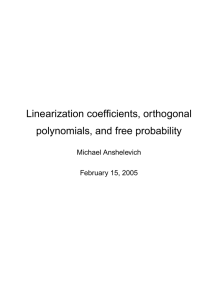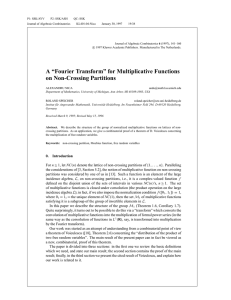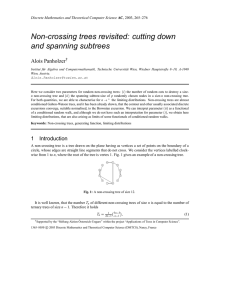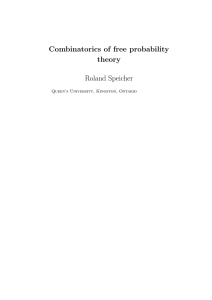From random matrices to free groups, through non-crossing partitions Michael Anshelevich
advertisement
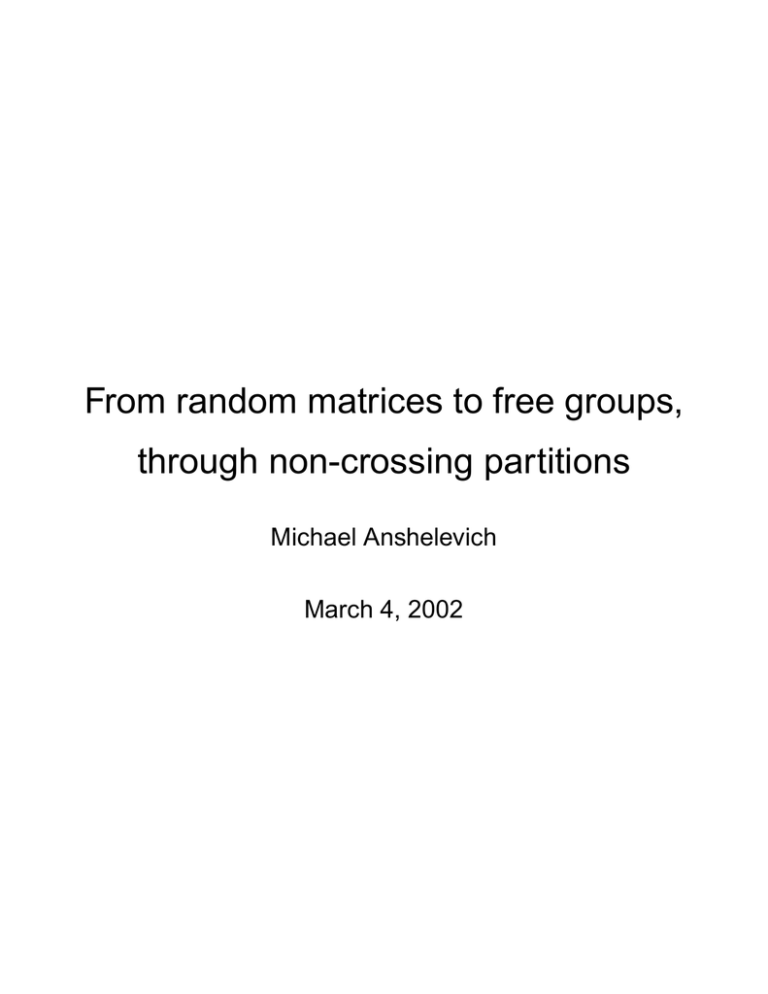
From random matrices to free groups,
through non-crossing partitions
Michael Anshelevich
March 4, 2002
R ANDOM
MATRICES
For each N , A(N ), B (N ) = independent N × N sym(N )
(N )
metric Gaussian random matrices, i.e. Aij
= Aji ,
1 ).
otherwise independent Gaussian N (0, N
Arise in: nuclear physics, quantum chaos, communication theory, string theory.
Want joint moments
1
Tr[p1(A(N ))q1(B (N )) . . . pk (A(N ))qk (B (N ))].
N
Example .
1
(N
)
Tr[(A(N ))2B (N )A(N )B (N )].
M
=
N
Note: this is a random variable.
1
Theorem . (Wigner ∼50)
1
N →∞
Tr[(A(N ))k ] −→
xk dσ(x)
N
the moments of the semicircular distribution
q
1
4 − x21[−2,2](x)dx.
dσ(x) =
2π
Z
Theorem . (Voiculescu ’91) If
R
qi(x)dσ(x) = 0, then
R
pi(x)dσ(x) = 0,
1
N →∞
Tr[p1(A(N ))q1(B (N )) . . . pk (A(N ))qk (B (N ))] −→ 0.
N
Note this is enough to find all moments, e.g.
1
(N
)
M
∼
Tr[((A(N ))2 − 1)B (N )A(N )B (N )]
N
1
1
+ Tr[1] Tr[B (N )A(N )B (N )] → 0.
N
N
2
F REE
GROUPS
F2 = free group on 2 generators {a, b}
= all words in a, b, a−1, b−1 with cancellations.
L2(F2) =
n
o
P
2
f : x∈F2 |f (x)| < ∞ , the Hilbert space
of all square-integrable functions on F2.
Each x ∈ F2 acts on L2(F2) by (Sx(f ))(y) = f (xy).
L(F2) = von Neumann algebra generated by all Sx. It
has a state ϕ[S] = hSδe, δei (“= f (e)”).
If ϕ[pi(a)] = 0, ϕ[qi(b)] = 0, then
ϕ[p1(a)q1(b) . . . pk (a)qk (b)] = 0.
3
F REE
PROBABILITY THEORY
Voiculescu (∼80): this says a, b are freely independent.
Large independent random matrices are asymptotically
freely independent.
Free probability: a non-commutative probability theory,
with “independence” replaced by “free independence”. Lives
“in the large N limit”, but not only there.
Many statements from probability theory have free analogs.
Theorem (Free central limit theorem). Let X1, X2, . . . , Xn
be freely independent with respect to a state ϕ, and have
mean 0 and variance 1. Then
X1 + . . . + Xn d
−→ σ.
√
n
4
Why semicircle appears in both contexts:
(N )
(N )
A1
. . . An
∼
↓
X1
...
↓
Xn
(N )
A1
(N )
+...+An
√
n
↓
∼
X1 +...+X
n
√
n
Have analogs of
• Infinitely divisible distributions
• Convolution and harmonic analysis
• Entropy
Connections to: combinatorics, representation theory, orthogonal polynomials, Yang-Mills theory, etc.
5
Another way to look at the CLT: as a fixed point theorem.
+X2
Corresponding to X1√
, have the operator
2
C : µ 7→ (µ µ) ◦ S1/√2.
σ is an attracting fixed point for it.
Behavior in the neighborhood of the fixed point (M.A.’99):
C is a non-linear operator. Its derivative is compact, with
eigenfunctions Tn∗, eigenvalues 21−n/2. Here Tn = Chebyshev polynomials of the 1st kind.
Have similar results for other free convolution semigroups
(M.A.’02).
6
Most importantly, applications to the theory of von Neumann algebras. Example: a von Neumann algebra is
prime is A =
6 ∼ B ⊗ C for any infinite-dimensional B, C.
A definition in search of an example.
∼ A ⊗ A common. For A = lim M ,
Why rare: A =
n
∼M 2
Mn ⊗ Mn =
n
∼
A⊗A
=A
II1-factors: von Neumann algebras with a trace and a
trivial center (≈ simple).
First known example of a prime II1-factor: L(Fn).
Still know little about L(Fn), for example do not know
∼ L(F ) (Kadison ∼60). Know that either all
if L(F2) =
3
∼ L(F ) for all r, s ∈ R ∪ ∞, or they are all
L(Fr ) =
s
+
non-isomorphic.
7
N ON - CROSSING
PARTITIONS
Free independence hard to use for calculations, e.g.
ϕ[ab2aba] =?
Speicher ’90:
ϕ[·] =
X
Rπ .
π∈NC (n)
NC (n) = non-crossing partitions.
R = free cumulant functional,Rπ =
ample,
Q
B∈π RB . For ex-
R(1,5)(2,3)(4)(X1X2X3X4X5)
= R(X1X5)R(X2X3)R(X4).
8
Here rk = R(ak ) = free cumulants of a.
Why simplifies calculations: R(free variables) = 0.
This implies the free independence property.
ϕ[a1b1a2b2 . . . anbn] =
X
Rπ (a1b1a2b2 . . . anbn).
π∈NC (2n)
π connect only a’s to a’s, b’s to b’s ⇒ π contains a singleton.
Each a, b centered ⇒ each term is 0.
Example .
ϕ[ab2aba]
= R(a)3ϕ[b3] + R(a2)R(a)ϕ[b2]ϕ[b] + R(a3)ϕ[b2]ϕ[b]
9
Non-crossing partitions and random matrices:
1 X
1
4
E[Tr[A ]] =
E[Aij Ajk Akl Ali]
N
N i,j,k,l
Gaussian matrices: all moments expressed through the
2nd order moments.
E[
X
Aij AjiAik Aki
i,j,k
+
X
Aij Ajk Akj Aji
i,j,k
+
X
AiiAiiAij Aji
i,j
+ more terms]
10
Another appearance of non-crossing partitions. Let {X(t)}
be a process. Let π be any partition, for example
π = (1, 3, 5)(2, 4, 6)
The corresponding stochastic measure is
Stπ (t)
=
Z
[0,t)2
dX(s1)dX(s2)dX(s1)dX(s2)dX(s1)dX(s2).
Defined and investigated by Rota and Wallstrom ’97 for
{X(t)} a (classical) Lévy process.
11
For scalar-valued measures,
Z
[0,1)2
dµ(s)dν(t)
=
Z 1
0
µ([0, t))dν(t) +
Z 1
0
ν([0, s))dµ(s)
(+
Z 1
0
If X(t) are operators,
1
1
1
=
dX dX 6= 0. For example,
1
1
1
1
R
dµ(s)dν(s)).
1
0
0
+
0
0
1
0
+
0
0
1 0
+
0
1
0
0
1
Z
0
1
1
0
(↔ X(s)dX(s))
+
=
0
0
1
1
0 1
0 0 Z
0
1
0
1
+
+
(↔ dX(s)X(s))
1
0
0
1
0
0
1
0
1
1
0
0
0
0
+
+
+
0
0
1
1
0
0
0
0
0
0 Z
1
1
×
0
+
(↔
dX(s)dX(s))
12
Instead, let {X(t)} be a bounded free Lévy process, i.e.
a stationary (operator-valued) process with freely independent increments.
Theorem . (M.A.’00) Stπ are well-defined. Moreover,
Stπ = 0 unless π is non-crossing.
Why want Stπ : can write products of multiple integrals as
sums of integrals with respect to stochastic measures (Itô
formulas).
Example .
(
Z
dX(s)dX(t)) · (
Z
dX(u)dX(v))
= St(1)(2)(3)(4) + St(1,3)(2)(4) + St(1)(2,4)(3).
13
Relation to free cumulants: Rπ = ϕ[Stπ ].
In fact (M.A.’01) Stπ can be expressed through simple
multiple integrals and the free cumulants dependent on
the inner classes of the non-crossing partition π.
Example .
St(1)(2,6)(3,4)(5)(7,8)(t)
=
Z
[0,t)5
dX(s1)d∆2(s2)r2ds3r1ds4d∆2(s5),
Rt
where ∆k (t) = 0(dX(s))k are the higher diagonal
measures (higher variations).
14
Other projects:
• Relate the “linearization around the fixed point” results to fluctuation results for random matrices.
• Develop stochastic integration with respect to free
processes. Partially done (M.A.’02), need more machinery, martingale inequalities etc. What algebras
do these processes generate?
(Free n-dimensional Brownian motion generates L(Fn)).
• q-interpolations between the free and the classical
world. Free corresponds to q = 0, while q = 1 is
symmetric and q = −1 is anti-symmetric. Partially
done: q-Lévy processes (M.A.’01). Have an interesting relation to the theory of orthogonal polynomials
in the free case (M.A.’02). Would like such a relation
for other q.
• Relate the free Lévy process results to the representation theory of S∞ (Biane).
15

